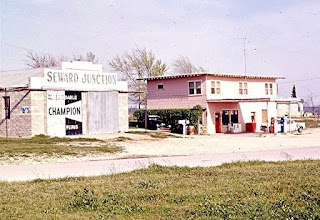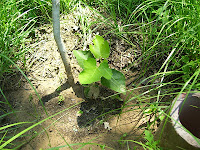DONUTS AS A SPIRITUAL PRACTICE!
It's been a good while since I've had really good donuts. I lived in Round Rock, Texas for many years. Round Rock was a great little town. In my time there, three of the greatest things that made it stand out were THE Round Rock, the outlaw Sam Bass, and Round Rock Donuts. In Round Rock the donuts were pretty ubiquitous. Just about any gathering had a few. Church fellowship halls had them. If you worked anywhere in the area you could get absolution for arriving late if you showed up with a dozen Round Rock donuts. All work tended to stop for an impromptu coffee break but the bosses were usually there munching away with the hoi polloi.
I moved away from Round Rock in the late '90's and lost touch with the donuts except for a rare glimpse now and then. When I finally moved to the Bastrop area in 2007 I could no longer get the donuts at all unless someone made a special trip. It seemed easier to just give up on donuts in general except for a rare grocery store donut nabbed when shopping. (And paid for, of course!)
I certainly don't want to denigrate any other brand of donuts. I've eaten at least a few of them all. Like a few other things in my experience, no donut is a bad donut. To my particular taste, however, one donut reigns supreme.
I've essentially been on a donut hiatus for about five years.
In that time period the legendary (to me, anyway) Round Rock Donuts loomed rather large in memory. Not unlike this:
 |
| (Lone Star Bakery, the home of the RR Donut, does have one like this, called, I think, the Texas Donut.) |
Recently, my daughter Holly Seward Land and her husband Jeremy were coming to visit from their home in Temple. Realizing that they would likely pass more or less through Round Rock, I asked them to pick me up some donuts. Being a RR girl, in fact a RR Dragonette in her time, I didn't have to explain. They appeared in my yard with a dozen RR Donuts, which I promptly put in the freezer. They freeze wonderfully well. Pull one out, microwave for 15 seconds or so, and they are almost fresh again, or near enough anyway.
They were every bit as good as I remembered. My partner, Cat Dancing, didn't see the appeal at all. I love her madly and would have gladly shared, however it just means my stash lasts longer! The first batch lasted me about a week, as I was eating two every morning with coffee. Is there a more perfect union?
I often arise earlier than anyone else here at EarthSong. I feed the chickens, dog, and cats, make coffee and have perhaps an hour to myself for coffee and reflection. I started joking on Facebook about my morning spiritual practice; Donuts and coffee. It got a lot of likes and virtual smiles. Alas, the donuts were soon gone and I had to make do with Christmas cookies and so on. I was roughing it, you know! Pan Dulce is an excellent alternative!
I got another dozen donuts a couple of days ago. Holly and Jeremy came to visit again and vowed to continue enabling my addiction whenever possible! I think she wants to be my favorite! I'm a lucky daddy! Have I mentioned I'm a soon to be grandpa too? More on that later.
It is fitting, though. My own initiation to the donut came through my own grandfather, W.K. Seward (Dad). We lived at our gas station at Seward Junction, three miles outside of Liberty Hill, Texas.
Roughly twice a day Dad would drive into Liberty Hill for his coffee break. Occasionally he would take me and my brother Steve along. I was small, but felt like big stuff to sit up at the counter at Foust's Cafe beside him. He would treat me to a drink, an ice cream, and sometimes a donut! He would always make me a deal. I could eat the donut but I had to save him the hole!I tried. It was a concept that confused me, but intrigued me. The donuts at Foust's Cafe were, I suppose, made there. There were few donut chains around in the mid '50's, at least in our area. I remember the donuts fondly, if a bit fuzzily. This was before such bakers as Dunkin Donuts actually made a treat called the "donut hole" that actually could be eaten.
So, I was faced with a dilemma. I took Dad seriously at first. My young mind wrestled with the concept of saving a thing which was apparently a nothing. Even after I realized he was joking, the idea had an appeal.
(It is only now, fifty-something years later, that I realize he might possibly have meant "save me the whole", which would have been a whole other thing. Surely he didn't. Maybe.)
I was thus, early on, faced with the task of "unscrewing the inscrutable". Perhaps this was the beginning of my tendency to take nothing at face value. To question what I was told! Maybe it's just a donut!
What is a donut but a torus? Wikipedia has a fascinating and pretty technical explanation of a torus. Click the link if you want to go into it. Basically, a torus is a solid with only one surface. It is made from rotating one circle around another. The figure has a lot of practical uses, from the small donut I enjoy to the huge Super Colliders we use to generate new particles. Pretty interesting.
How about that hole? Negative space in the center of the torus? Portal to other spaces? Navel of the cosmos? Something to contemplate, at least. And of course, getting down to the hole is very tasty!
The best way to consider such things is to have a donut or two, and some coffee, and think about it!
Save me the hole! Or maybe the whole, if it's the last of the RR Donuts!
The Road Goes Ever On...







































